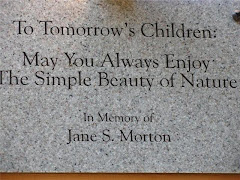I enjoy walking and exploring the Schedel Arboretum and Gardens in Elmore, Ohio. It was created by the village's “founding father,” Israel Harrington, but was never developed by him. Eventually, a local businessman in Elmore ended up owning the property and his nephew, Frederick Steiffler, occupied the beautiful home and grounds when Joe Schedel was a border there. Schedel took a 99 year lease on the house and land in the late 1920s and eventually purchased the land outright in 1969.
Unfortunately, the Ohio Turnpike bisected the estate in 1955 and greatly reduced its size. This prompted the Schedel family to create the Japanese garden in the floodplain and also construct the “Shack.” (The Schedel’s summer home adjacent to the lakes in the lowland area of the grounds).
Those who desire to create a wildlife-friendly yard may want to tour the Schedel Arboretum and Gardens, for they were proficient in landscape and horticulture. Plus, Joe Schedel was also an award winning ornithologist. He raised rare birds and waterfowl on the property… some of which had NEVER been bred and reared in captivity before (the Australian Shell Duck is one example). Mrs. Schedel even had a couple of “pet” birds that were trained to “play ball” and would come to her like a cat or dog when called!
Joe Schedel passed away in 1981and his wife, Marie, stopped maintaining the grounds. Between his passing and hers in 1989, the estate began to fall into a state of disrepair. Then, when Marie Schedel died in 1989, the Schedel Foundation took possession of the estate and started the task of returning this gem in Elmore, Ohio to its current state. The gates opened to the public in 1991, but on July 12, 1992, a tornado touched down in the gardens and extensively damaged the house, the Japanese garden and destroyed 131 mature trees.
I emailed Kendra Schwartz, Assistant Grounds Superintendent at the arboretum, asking her what type of plants are best to attract wildlife. Here is her reply to me:
I emailed Kendra Schwartz, Assistant Grounds Superintendent at the arboretum, asking her what type of plants are best to attract wildlife. Here is her reply to me:
"Hello,
There are so many plants that you could plant to attract wildlife. Please remember when you plant flowers and shrubs to attract butterflies and hummingbirds you will also get bees. One annual we plant at the gardens that the hummingbirds and all varieties of butterflies love is Lantana. Lantana comes in all different colors and is an easy annual to grow. Some other annuals are: Cleome Spider flower, Cosmos, Globe Amaranth, Sweet Alyssum, Zinnia, Salvia, and many others. Some perennials are: Columbine, Coreopsis, Foxglove, Coneflower, Globe Thistle, Coral Bells, Shasta Daisy, Liatris, Monarda, Nepeta, Garden Phlox, Black-eyed Susan, some sedum, and many many others.
Some shrubs are: Butterfly Bush, Viburnums, Hydrangea, Lilac, and any others that flower, A tropical plant that attracts a lot of butterflies and hummingbirds is the hibiscus. You would have to bring that indoors for the winter however.
I did find a couple links that you may find helpful:
I hope this helps and if you have any other questions please feel free to email me back.
Thanks,
Kendra"
Kendra Schwartz, Assistant Grounds Superintendent
Schedel Arboretum and Gardens
19255 West Portage River Road South
Elmore, OH 43416
Thank you, Kendra Schwartz! I am working on creating my own private nature preserve; i.e., my yard. Visiting places like Schedel Arboretum and Gardens reinvigorates me to do so. It's a wonderful experience to turn a typical yard into a beautiful natural habitat for birds and other wildlife. I enjoy watching birds gobble seeds and other treats from my bird feeders, eating fruits and seeds from the indigenous plants, and delight as a mother bird feeds her babies in the protective hideaway of a birdhouse constructed from a dried gourd. So many are missing the fun of transforming a barren, dead zone of chemlawn and pesticide-sprayed grass turf into an enticing playground, breeding ground, and feeding ground for colorful songbirds, butterflies, toads, insects, butterflies and a host of other living creatures.
